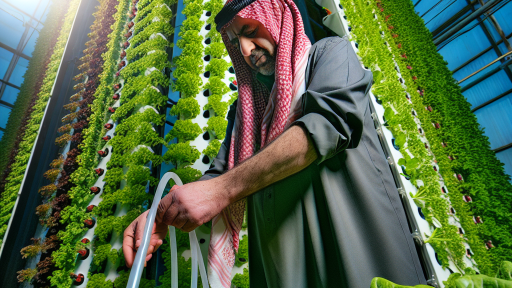Understanding the Basics of Farm Robotics Maintenance
Importance of Regular Maintenance
Regular maintenance keeps farm robotics operating smoothly.
It prevents unexpected breakdowns that disrupt farm operations.
Additionally, proper care extends the lifespan of the equipment.
Farmers should schedule maintenance checks regularly.
Common Maintenance Procedures
Inspecting software is crucial to ensure proper functionality.
Updating firmware helps maintain performance and security.
Cleaning sensors and cameras enhances data accuracy.
Lubricating moving parts minimizes wear and tear.
Checking battery health optimizes power efficiency.
Utilizing Manufacturer Resources
Each manufacturer provides specific maintenance guidelines.
Always refer to the operation manuals for detailed instructions.
Engage with customer support for any technical issues.
Take advantage of online resources and forums for tips.
Training and Skill Development
Proper training ensures staff can handle maintenance tasks effectively.
Workshops and seminars provide hands-on experience and knowledge.
Transform Your Agribusiness
Unlock your farm's potential with expert advice tailored to your needs. Get actionable steps that drive real results.
Get StartedEncourage team members to pursue certifications in robotics maintenance.
Staying current with industry trends enhances overall efficiency.
Developing a Maintenance Schedule
A maintenance schedule helps streamline the upkeep process.
Document routine checks, repairs, and replacements methodically.
Set reminders for upcoming inspections and updates.
Adjust the schedule based on equipment usage and performance.
Monitoring and Diagnostics
Utilize software tools for real-time diagnostics of farm robotics.
Collect data to identify patterns that may indicate issues.
Proactively addressing problems minimizes downtime.
Implementing monitoring systems enhances operational efficiency.
Routine Inspection: The Key to Longevity in Robotics
Importance of Regular Inspections
Regular inspections are crucial for maintaining farm robotics.
They help identify issues early and prevent costly repairs.
Furthermore, frequent checks ensure optimal performance.
Consequently, this leads to increased efficiency in farming operations.
Developing an Inspection Schedule
Creating a regular inspection schedule is essential for success.
Start by determining the frequency of inspections based on usage.
For example, high-use equipment may require weekly checks.
In contrast, less frequently used machines might need monthly reviews.
Key Areas to Inspect
Focus on specific components during inspections for thorough evaluations.
- Check the integrity of sensors and cameras.
- Inspect wheels and tracks for wear and tear.
- Review battery health and connections regularly.
- Assess software for updates and performance issues.
Documenting Findings
Maintain records of all inspections for future reference.
Documenting findings helps track performance over time.
This documentation can provide insights for preventative maintenance.
Additionally, records assist in warranty claims if necessary.
Utilizing Professional Services
Consider hiring professionals for comprehensive inspections.
Showcase Your Farming Business
Publish your professional farming services profile on our blog for a one-time fee of $200 and reach a dedicated audience of farmers and agribusiness owners.
Publish Your ProfileProfessional service providers possess specialized knowledge and skills.
They can identify potential issues that might go unnoticed.
Moreover, their expertise can enhance the reliability of your robotics.
Cleaning Protocols to Prevent Malfunctions in Farm Robots
Importance of Regular Cleaning
Regular cleaning of farm robots is essential for optimal performance.
It helps to prevent malfunctions and extends the lifespan of the equipment.
Moreover, keeping machinery clean benefits efficiency and productivity.
Establishing a Cleaning Schedule
A proactive approach involves creating a consistent cleaning schedule.
Schedule cleaning sessions after specific tasks or operating hours.
For example, clean the robots daily after use or weekly for general upkeep.
Recommended Cleaning Supplies
Use non-abrasive cleaners to avoid damaging sensitive components.
Additionally, gather microfiber cloths, brushes, and compressed air for cleaning.
These tools help in removing dirt, debris, and sticky residues effectively.
Steps for Proper Cleaning
Start by turning off the machine and disconnecting power sources.
Next, review the manufacturer’s guidelines for specific cleaning instructions.
Then, carefully remove any loose dirt with a soft brush.
Follow this by wiping down surfaces with a damp microfiber cloth.
Finally, inspect for any signs of wear or damage during the cleaning process.
Addressing Specific Areas
Pay special attention to high-contact areas like wheels and sensors.
These areas tend to accumulate dirt and can hinder performance.
Also, clean any storage compartments and ensure they are debris-free.
Post-Cleaning Maintenance Checks
After cleaning, perform a thorough inspection of all moving parts.
Check for any signs of malfunction or required lubrication.
Ensure all technology and sensors function correctly following the cleaning.
Updating software settings may also be necessary after maintenance.
Educating Staff on Cleaning Procedures
Train staff members on the importance of cleaning protocols.
They should know how to use cleaning supplies and tools safely.
Regular training sessions can reinforce the importance of these practices.
See Related Content: Automated Machinery Solutions for Small Farmers
Software Updates: Keeping Your Robotics System Current
The Importance of Regular Updates
Software updates significantly enhance your robotics system’s performance.
They introduce essential security patches to protect against vulnerabilities.
Moreover, updates can improve the functionality of existing features.
Keeping software current also ensures compatibility with new hardware components.
Setting Up Automatic Updates
Automatic updates save time and ensure your system remains current.
Most robotics systems have built-in options for scheduled updates.
Enable automatic updates to reduce the risk of outdated software.
Regular checks can help identify any missed updates.
Manual Update Checks
Occasionally, perform manual checks for updates.
Visit the manufacturer’s website for the latest software versions.
Downloading updates promptly helps maintain system efficiency.
Documenting update history assists with troubleshooting future issues.
Showcase Your Farming Business
Publish your professional farming services profile on our blog for a one-time fee of $200 and reach a dedicated audience of farmers and agribusiness owners.
Publish Your ProfileTesting Updates Before Full Implementation
Testing updates in a controlled environment is advisable.
This approach minimizes potential disruptions during the implementation.
Engage with your technical team to evaluate any changes thoroughly.
When issues arise, revert to the previous version quickly.
Training Staff on Update Procedures
Training staff on update processes improves overall system reliability.
Ensure everyone understands how to execute and verify updates.
Continuous learning helps staff stay informed about new features.
Seeking Support from the Manufacturer
Don’t hesitate to reach out to the manufacturer for assistance.
They often provide resources and guidelines on software management.
Engaging with support can clarify specific update processes.
Participate in forums or community discussions to gain insights.
Gain More Insights: Choosing the Right Automated Equipment for Your Farm
Troubleshooting Common Issues with Farm Robotics
Identifying Operational Problems
Farm robotics can face various operational problems in the field.
Understanding these issues is essential for quick resolution.
First, check for basic connectivity issues between components.
Ensure the control system is properly configured and connected.
Also, verify that power sources are functioning as intended.
Dealing with Mechanical Failures
Mechanical failures often arise in farm robotics during operation.
Inspect all moving parts for signs of wear or damage.
Lubrication is crucial for preventing friction-related problems.
Replace any damaged components promptly to ensure smooth operation.
Common Mechanical Issues to Monitor
- Belt and gear slippage
- Tire wear and damage
- Loose bolts and fasteners
Regular maintenance helps avoid these common issues.
Addressing Software Glitches
Software glitches can cause farm robotics to act erratically.
Update software regularly to fix bugs and improve performance.
Consider rebooting the system to clear temporary issues.
Check logs for any error messages that can guide troubleshooting.
Resolving Communication Errors
- Inspect network connectivity
- Ensure compatibility between devices and software
- Review settings for any misconfigurations
Proper communication configuration is vital for seamless operation.
Preventative Maintenance Strategies
Implementing a preventative maintenance schedule is beneficial.
Regularly inspect and maintain all robotic systems.
Document all maintenance activities for future reference.
This proactive approach can significantly reduce unforeseen issues.
Learn More: Monitoring Soil Health Using Remote Sensing

Implementing a Maintenance Schedule for Efficiency
Establishing Regular Check-Ups
Regular check-ups are essential for optimal performance of farm robotics.
These routine inspections help identify potential problems early.
Additionally, they can enhance the lifespan of equipment.
Develop a checklist to follow during these inspections.
Each robotic system should have a tailored maintenance checklist.
Monitoring Performance Metrics
Monitor performance metrics closely to track efficiency levels.
Regular data analysis helps identify trends and areas for improvement.
Use performance metrics to adjust maintenance schedules accordingly.
Showcase Your Farming Business
Publish your professional farming services profile on our blog for a one-time fee of $200 and reach a dedicated audience of farmers and agribusiness owners.
Publish Your ProfileConsider implementing a software solution to facilitate data tracking.
This will ease the identification of maintenance needs.
Training Staff on Equipment Use
Proper training ensures staff can operate farm robotics effectively.
Employees should understand both operation and maintenance protocols.
Regular training sessions should be part of your maintenance plan.
Investing in skilled personnel reduces the risk of equipment damage.
Moreover, well-trained staff can troubleshoot minor issues independently.
Utilizing Manufacturer Guidelines
Always refer to manufacturer guidelines for maintenance specifics.
These guidelines provide detailed information for equipment upkeep.
Moreover, they often include warranty considerations for maintenance.
Follow these recommendations closely to avoid costly repairs.
Consider scheduling maintenance during off-peak seasons to minimize disruption.
Documenting Maintenance Activities
Keep detailed records of all maintenance activities performed.
Documentation should include dates, tasks completed, and observations.
This record will be invaluable for future reference and audits.
Sharing this information with your team fosters accountability.
Additionally, it aids in identifying long-term patterns.
Delve into the Subject: Advanced Technologies Enhancing Vertical Farming Practices
Training Staff on Proper Use and Care of Robotic Equipment
Importance of Proper Training
Training staff is crucial for successful robotic equipment use.
Well-trained employees ensure safety during operations.
They can identify and address minor issues before they escalate.
Additionally, proper training enhances the lifespan of the equipment.
Developing a Training Program
Create a comprehensive training program for all staff members.
Incorporate hands-on sessions to reinforce learning.
Use visual aids, such as videos, to explain complex concepts.
Schedule regular training updates as new equipment is introduced.
Key Topics to Cover
Start with an overview of the robotic equipment specifications.
Include safety protocols and emergency procedures in the curriculum.
Demonstrate proper operating techniques and maintenance routines.
Encourage staff to ask questions to solidify their understanding.
Utilizing Experienced Personnel
Assign experienced employees as trainers for new hires.
Leverage their knowledge to provide practical insights.
Encourage mentorship between seasoned staff and trainees.
Monitoring Training Effectiveness
Evaluate the effectiveness of the training program regularly.
Seek feedback from participants to identify areas for improvement.
Conduct assessments to measure knowledge retention and skills.
Adjust the training content based on performance outcomes.
Utilizing Sensors and Diagnostics for Proactive Maintenance
The Role of Sensors in Farm Robotics
Sensors play a crucial role in farm robotics maintenance.
They provide real-time data on equipment performance.
By monitoring variables, sensors detect potential issues early.
Showcase Your Farming Business
Publish your professional farming services profile on our blog for a one-time fee of $200 and reach a dedicated audience of farmers and agribusiness owners.
Publish Your ProfileThis data allows farmers to react promptly.
Types of Sensors in Use
Load sensors measure the weight handled by the robotic equipment.
Temperature sensors monitor operating temperatures during use.
Vibration sensors detect irregularities in machinery operation.
Moisture sensors check soil conditions for proper irrigation management.
Diagnostics and Data Analysis
Regular diagnostic checks are essential for effective maintenance.
Data analysis can pinpoint trends and recurring problems.
This approach enables predictive maintenance strategies.
By understanding these trends, farmers can schedule repairs proactively.
Integrating Technology for Maintenance
Integrating advanced technology streamlines the maintenance process.
Cloud-based platforms help in storing and analyzing data.
Moreover, mobile applications can provide immediate alerts on malfunctions.
Farmers can quickly assess situations before they escalate.
Benefits of Proactive Maintenance
Proactive maintenance minimizes downtime of farm robotics.
This approach maximizes operational efficiency and productivity.
Additionally, it reduces repair costs in the long term.
Ultimately, farmers gain peace of mind and better returns on investment.




